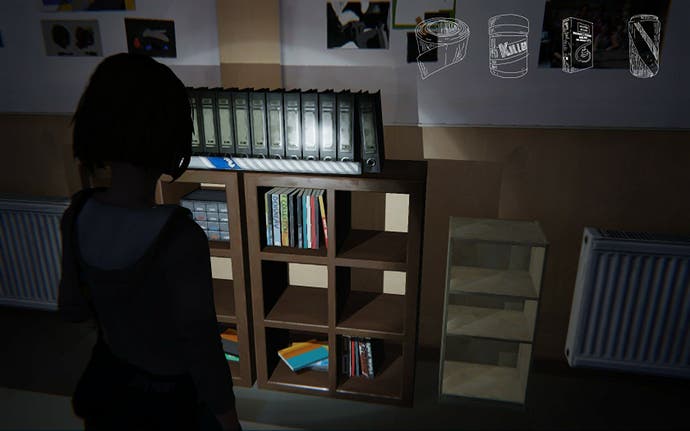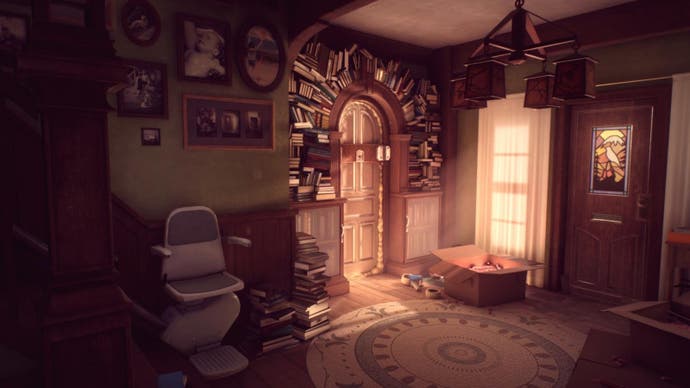Let's go bookshelf snooping in games
Shelf-life.
A few years back, browsing on Instagram, I was delighted to see a book I knew. The spine of it, anyway: a perfect bolt of cheery gold, stacked neatly on a shelf by some plants. The book was Kenny Shopsin's life-changingly great cookbook Eat Me, which I absolutely recommend, and the shelf it was on formed part of a cookbook library in Shake Shack's test kitchen. I emailed Shake Shack about this, because I am weird and because I am always hoping for an invite to a test kitchen, but even before they got back to confirm that they loved Shopsin as much as I do, I knew I was right in my identification of that book. Shake Shack and Shopsin made a lot of sense. And seeing the book there on that shelf was a chance to spot a new, illuminating connection between two things I already loved.
Anyway. I've always been a bit of a bookshelf snooper. Not in friends' houses, necessarily, which always feels like a bit of a step too far. But the bookshelves of people I don't know feel like fair game. In movies, I always lean forward trying to see what the heroes and villains have on their shelves. On CNN I can't help but scan what the people being interviewed on Zoom have stacked behind them.
Games are great for this too, but in quite unusual ways. You rarely get that flash of recognition - the Shopsin, or that classic '70's Tolkein with the memorable yellow spine - from looking at a bookcase in a videogame. But you might get something else: a hint at what the developer values, a suggestion of how much time the team had to lavish on the little things. And more. So, let's go. Let's go bookshelf snooping in games.

First stop, Life is Strange. And this is a strange case, as it happens, because it's not the books but the shelf itself that stood out to me. In Max's dorm room, over by the computer desk, I once spotted what looked very much like an Ikea Expedit, the classic book/record shelf unit that was so beloved that it made the front page of the Guardian when it was replaced with the similar, but not identical, Kallax. Weirdly, Max's Expedit was a 2x3, a form that did not exist in the real world. The horror!
That fascinated me at the time - I am boring as well as weird - but what I really loved, looking back, was all the times I then saw this Expedit unit elsewhere in the game. Recognition had made it visible to me all of a sudden. It was like having a very dull superpower. There it was in the principal's office in a break-in scene. There it was in a classroom. Once I started spotting it I couldn't stop, and along with all these bursts of recognition, I felt like I'd had an insight into Life is Strange I wouldn't have otherwise had. The set dressers for this game were ingenious, and they were thrifty. They had a set number of pieces to deploy in the world, a limited art budget, as it were. And they made that Expedit work for them - cloning it, standing it on its side, hanging it on the wall, partially obscuring it. It was one of the fundamental atoms of the Life is Strange cosmos. Just recognising it got me closer, it felt, to the other side of the game - the side where everything was being constructed for players to enjoy.
It was around this time I encountered Hyper Light Drifter, I reckon, which is one of the very best examples of the bookshelf as set-dressing. Bookshelves can be evocative! They can do more for the lore of a game, I think, than a dozen nicely conceived audio diaries. I was climbing a mountain in Hyper Light Drifter, which meant flitting between the exposed face of the cliff, ancient steps, and odd little caverns where structures had been built into the living rock. The higher I got, the more the chill was evident in the air, the more I started to see bookcases, until I was in a proper mountaintop library. What a beautiful thing!
I think of this library often - along with a library in Solar Ash, from the same team. The Hyper Light Drifter library is so special I think because its order is giving way to entropy. Shelves are partially collapsed, pages are spilled onto the floor, and I think there's the odd skeleton lying slumped in a corner as if they died while reading. Walls have been caved in and the mountain weather is reclaiming this space, and soon, perhaps, nobody will be able to make use of it.
And here's the other thing - I couldn't make use of it in the game. It was set dressing, so I couldn't pull books down or even read their titles. But it was also more than set dressing, somehow, because it seemed to tell me so much about the people who put it there. How they loved order, loved keeping track of things, loved having the details and history of the world within reach. Here was a chance to see what was being lost by the point I arrived in the game - a chance to see what had already been lost.

Chilly stuff! In terms of books I could peruse a bit more, we need to turn to What Remains of Edith Finch, a game set in a rickety and rambling house that is a library as well as a family home. All of the family's history is here - in a neat opposite to Hyper Light Drifter, the problem, I think, is that the history is too present, and the Finches could do with a bit more forgetting and expunging. And all of the family's books are here. Shelves on every wall, volumes spilling over onto kitchen workspaces, nooks for more books arranged rather beautifully around at least one door.
And you can look at the spines of these books and read the names! I can only remember one off-hand, because it's a favourite. Gravity's Rainbow, a proper classic that I should probably read again. The Finch house has several copies of it which I like to think of as a comment on the way that families double- and triple-up on books when people die and personal libraries are subsumed. Sure, it's probably the limited time or art budget Expedit story from Life is Strange, but it does also work as a slightly spooky window on the way a family's personal library grows and consolidates over time. All those people independently reading Gravity's Rainbow, leaving their own marginalia, their own conflicting ideas about the symbolism of the windmill reflected in whatnot's eye. (No idea personally.)
Here's the thing. Being a bookcase spotter in games is a lovely passtime, because bookcases are everywhere in games. They're useful ways to fill a space and make it lived in. They give your eye something interesting to do as you ponder the layout of books and try to spot the copy-and-paste repetitions. Making a bookcase of your own in Animal Crossing is surprisingly knackering, but I've done it, multiple times, because I felt that my house needed it. Games need bookcases just like we need bookcases on this side of the screen. They are a neat artifact of being human and having a personal history.
The last bookcases I really looked at were in Marvel's Midnight Suns, I think. There's a library, with its own ghost, which is always money in the bank, and there's a book club, which meets every few nights, and was organised - I love this - because Blade fancies Captain Marvel, and then Captain America joined too because he's gentle and oblivious and always interested in a spot of self-improvement.
Cool shelves, too, as you'd expect from Firaxis, a developer that loves to tinker with things. As far as I can tell, the bookshelves had a scattering of interactive spots where you could read a title of a volume or even a bit of text from inside. Lovely stuff! But brilliantly, there were only ever a few interactive spots, and they seemed to change whenever I went into the library.
Nice! The game was using bookcases to give me a bit of distance from my character, it felt. I was controlling them, but they had control over the books that took their fancy on that particular day.
And, as a bookcase owner who has his fair share of Expedits and Kallaxes, I know that feeling very well.


